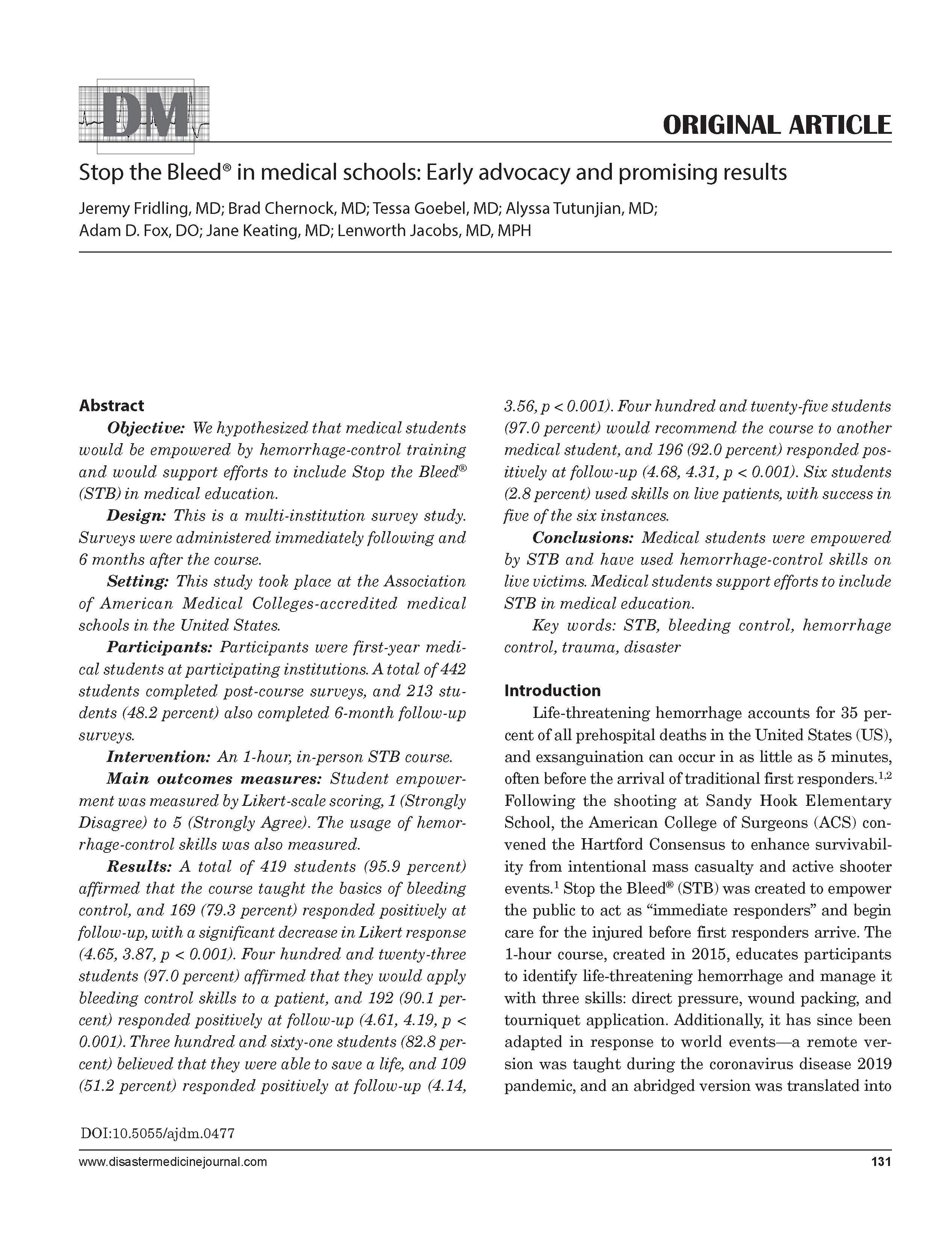Stop the Bleed® in medical schools: Early advocacy and promising results
DOI:
https://doi.org/10.5055/ajdm.0477Keywords:
STB, bleeding control, hemorrhage control, trauma, disaster, Stop the Bleed®Abstract
Objective: We hypothesized that medical students would be empowered by hemorrhage-control training and would support efforts to include Stop the Bleed® (STB) in medical education.
Design: This is a multi-institution survey study. Surveys were administered immediately following and 6 months after the course.
Setting: This study took place at the Association of American Medical Colleges-accredited medical schools in the United States.
Participants: Participants were first-year medical students at participating institutions. A total of 442 students completed post-course surveys, and 213 students (48.2 percent) also completed 6-month follow-up surveys.
Intervention: An 1-hour, in-person STB course.
Main outcomes measures: Student empowerment was measured by Likert-scale scoring, 1 (Strongly Disagree) to 5 (Strongly Agree). The usage of hemorrhage- control skills was also measured.
Results: A total of 419 students (95.9 percent) affirmed that the course taught the basics of bleeding control, and 169 (79.3 percent) responded positively at follow-up, with a significant decrease in Likert response (4.65, 3.87, p < 0.001). Four hundred and twenty-three students (97.0 percent) affirmed that they would apply bleeding control skills to a patient, and 192 (90.1 percent) responded positively at follow-up (4.61, 4.19, p < 0.001). Three hundred and sixty-one students (82.8 percent) believed that they were able to save a life, and 109 (51.2 percent) responded positively at follow-up (4.14, 3.56, p < 0.001). Four hundred and twenty-five students (97.0 percent) would recommend the course to another medical student, and 196 (92.0 percent) responded positively at follow-up (4.68, 4.31, p < 0.001). Six students (2.8 percent) used skills on live patients, with success in five of the six instances.
Conclusions: Medical students were empowered by STB and have used hemorrhage-control skills on live victims. Medical students support efforts to include STB in medical education.
References
Jacobs LM, McSwain NE, Jr, Rotondo MF, et al.: Improving survival from active shooter events: The Hartford consensus. J Trauma Acute Care Surg. 2013; 74(6): 1399-1400.
Kauvar DS, Lefering R, Wade CE: Impact of hemorrhage on trauma outcome: An overview of epidemiology, clinical presentations, and therapeutic considerations. J Trauma. 2006; 60(6 Suppl): S3-S11. DOI: 10.1097/01.ta.0000199961.02677.19.
Jacobs L, Keating JJ, Hunt RC, et al.: Stop the Bleed®. Curr Probl Surg. 2022; 59(10): 101193. DOI: 10.1016/j.cpsurg.2022.101193.
Goralnick E, Chaudhary MA, McCarty JC, et al.: Effectiveness of instructional interventions for hemorrhage control readiness for laypersons in the Public Access and Tourniquet Training Study (PATTS): A randomized clinical trial. JAMA Surg. 2018; 153(9): 791-799. DOI: 10.1001/jamasurg.2018.1099.
Schroll R, Smith A, Martin MS, et al.: Stop the Bleed training: Rescuer skills, knowledge, and attitudes of hemorrhage control techniques. J Surg Res. 2020; 245: 636-642. DOI: 10.1016/j.jss.2019.08.011.
Levy-Carrick NC, McCarty JC, Chaudhary MA, et al.: Hemorrhage control training promotes resilience-associated traits in medical students. J Surg Educ. 2019; 76(1): 77-82. DOI: 10.1016/j.jsurg.2018.06.007.
Fridling J, Feinn R, Jacobs L: Lives saved and public empowerment 1 year after bleeding control training. J Am Coll Surg. 2020; 231(4): S321-S322.
Katzer RJ, Duong D, Weber M, et al.: Management of in-flight medical emergencies: Are senior medical students prepared to respond to this community need? Western J Emerg Med. 2014; 15(7): 925-929.
Kaiser HE, Barnett DJ, Hsu EB, et al.: Perspectives of future physicians on disaster medicine and public health preparedness: Challenges of building a capable and sustainable auxiliary medical workforce. Disaster Med Public Health Prep. 2009; 3(4): 210-216.
Chernock B, Fisher A, Gallagher K, et al.: Letters to the editor: It is time to mandate bleeding control training in medical schools. Bull Am Coll Surg. 2019; 104(2): 52-53.
Fridling J, Van Cott C, Violano P, et al.: Establishing the first Hartford consensus-compliant medical school in the United States. J Trauma Acute Care Surg. 2019; 86(6): 1023-1026.
Chernock B, Anjaria D, Traba C, et al.: Integrating the bleeding control basic course into medical school curriculum. Am J Surg. 2020; 219(4): 660-664.
Gowen JT, Sexton KW, Thrush C, et al.: Hemorrhage-control training in medical education. J Med Educ Curr Dev. 2020; 7: 238212052097321.
American College of Surgeons Committee on Trauma: Teaching bleeding control. 2017. Available at https://www.stopthebleed.org/media/4llbpxc5/bleeding-control-basic-course-guidelines.pdf. Accessed December 14, 2017.
Na JU, Sim MS, Jo IJ, et al.: Basic life support skill retention of medical interns and the effect of clinical experience of cardiopulmonary resuscitation. Emerg Med J. 2012; 29(10): 833-837. DOI: 10.1136/emermed-2011-200633.
Avisar L, Shiyovich A, Aharonson-Daniel L, et al.: Cardiopulmonary resuscitation skills retention and self-confidence of preclinical medical students. Isr Med Assoc J. 2013; 15(10): 622-627.

Published
How to Cite
Issue
Section
License
Copyright 2007-2025, Weston Medical Publishing, LLC and American Journal of Disaster Medicine. All Rights Reserved.

